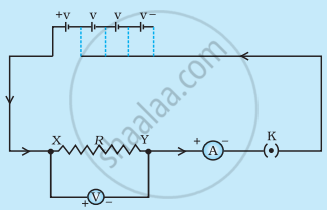Advertisements
Advertisements
प्रश्न
State Ohm’s law? How can it be verified experimentally? Does it hold good under all conditions? Comment.
उत्तर
Ohm's Law states that at constant temperature, potential difference across a conductor is directly proportional to the current passing through it.
Mathematically
V ∝ I
`"V"/"I" = "R"`
where,
V = potential difference
I = current
R = Constant of proportionality and it is called Resistance
Experimental verification of Ohm's law:
Material needed: a nichrome wire, an ammeter, a voltmeter, three cells, key etc.,
Procedure:
- Create a circuit as shown in the diagram, consisting of a nichrome wire XY of length, say 0.4 m, an ammeter, a voltmeter and three cells of 1 V each. Place all the equipment properly.

- First use only one cell as the source in the circuit. Note the reading in the ammeter I, for the current and reading of the voltmeter V for the potential difference across the nichrome wire XY in the circuit. Mark the corresponding readings in the Table given.
- Now connect two cells in the circuit and note the respective readings of the ammeter and voltmeter for the values of current through the nichrome wire and potential difference across the nichrome wire.
- Calculate the ratio of potential difference V to current I for each step.
Then plot the graph between potential difference and the current.
The graph between potential difference and the current is observed to be a straight line passing through origin. The slope of V-I graph indicates the resistance of the circuit. This verifies Ohm's law.S. No. Number of cells used in the circuit Current through the nichrome wire, I (ampere) Potential difference across the nichrome wire, V (volt) V/I
(volt/ampere)
1 1 2 2 3 3 4 4 
Ohm's law does not hold good under all conditions. It is obeyed by metallic conductors only when physical conditions like temperature etc. are kept unchanged and ideal. It is not obeyed by semiconductors, junction diode, thermistor etc. These are called non-ohmic conductors.
APPEARS IN
संबंधित प्रश्न
In a conductor 6.25 × `10^16` electrons flow from its end A to B in 2 s. Find the current flowing through the conductor (e = 1.6 × `10^-19` C)
How would you connect two resistors in series? Draw a diagram. Calculate the total equivalent resistance.
Tick(✓) the correct choice in the following:
Ohm's law is applicable to
Define ampere and volt with respect to Ohm’s law.
What are non-ohmic conductors? Give one exmaple. Draw a current-voltage graph for a non-ohmic conductor.
An ammeter placed in series with an electric radiator reads 0.5 amps and a voltmeter placed across it reads 230 volts. What is the resistance of the radiator?
Choose the correct alternative.
Which of the following is an ohmic conductor?
Define temperature coefficient of resistance.
Consider a current carrying wire (current I) in the shape of a circle. Note that as the current progresses along the wire, the direction of j (current density) changes in an exact manner, while the current I remain unaffected. The agent that is essentially responsible for is ______.
What is the resistance of a conductor through which a current of 0.5 A flows when a potential difference of 2V is applied across its ends?
